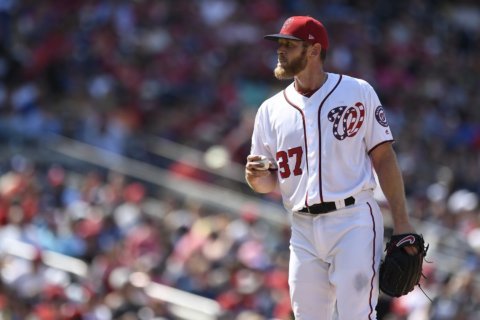WASHINGTON — Back on June 28, the Houston Astros led the American League West, the Oakland Athletics were buried 10.5 games out, and I was about to talk to two writers about anything but the current state of affairs in baseball. Little did I know that both of them — Michael Lewis and Rob Neyer — had books slated to come out this fall, the latter’s of which dovetails as something of an update to where the game has gone since the 2003 publication of Lewis’s “Moneyball,” perhaps the most influential baseball book of my lifetime.
That new tome is titled “Powerball: Anatomy of a modern baseball game,” the cadence of the subtitle even evocative of Lewis’ own (“The art of winning an unfair game”). Fittingly, it is told through the nine innings of a Sept. 2017 tilt between the eventual World Champion Astros and this year’s breakout team, the A’s, a prism that allows Neyer to dive into the game’s many evolutions and transformations both on and off the field.
Back in June, Lewis and Neyer were both in D.C. as part of a discussion tied to the opening of the Baseball Americana exhibit at the Library of Congress, which even includes “Moneyball” on display. And while the term is thrown all around both within baseball and beyond it to mean any number of things, really, at its core, it’s not about walks, or on-base percentage, or a 20-game win streak in 2002.
“If I only have one sentence, I say it’s about the way markets misvalue people, even when those people are seemingly so easy to value as professional baseball players,” said Lewis. “And if the markets can so misvalue professional baseball players, who can’t they misvalue? That’s the heart of the story.”
At the heart of Neyer’s story is how baseball’s evolved in the intervening 15 years, with terabytes more data and scores more analysts across MLB front offices hired to sift through it. From the home run and strikeout booms to the advent of Statcast, some of the changes are obvious and endemic. But baseball has also evolved in countless, incremental ways we take for granted — from instant replay, to concussion protocol, to the Chase Utley Rule — each of which Neyer finds ways to weave in through the context of this single game.
It’s impressive, really, just how many ties he’s able to establish without feeling like he’s reaching. And considering this particular game was chosen last September, before the postseason, it was pure coincidence that he ended up with last year’s World Series winner and this season’s most surprising team.
“In a sense, I wanted something forgettable,” he said when choosing the game, which was one among several he picked from. “I wanted to write about one of those teams at the forefront of using modern baseball tools.”
The Astros are certainly that, and if the Moneyball A’s invented modern baseball, Neyer anoints what’s going on in Houston (and with the Cubs in Chicago) as Postmodern Baseball. Part of that entails the strategic decision to essentially punt several seasons in order to build a roster that can compete for a World Series down the line, a plan that has worked to perfection for the Cubs and Astros over the past two seasons.
Neyer’s neither a particular proponent, nor opponent of this strategy insofar as it affects fan interest.
“The best way to create and attract fans is to win a lot. Not 82 games, but a lot,” he said, but acknowledged the cost of getting to that point. “You may definitely lost some long-term fans, because there are sweet spots when it comes to developing baseball fandom.”
When it comes to addressing the increase in the three true outcomes — walks, strikeouts and home runs — that dominate today’s game, Neyer doesn’t offer a silver bullet for creating more action, but also doesn’t buy the solutions floated about to affect change, particularly banning shifts.
“Sure, you’ll have a few more line drives and ground balls, but you don’t really get at the heart of the problem, which is lack of balls in play. Banning the shift wouldn’t change that at all,” he said.
“If we’re going to do these things, we should at least know why we’re doing it and have a reason for it.”
In fact, as Neyer points out in the book, league batting average on balls in play has barely budged in the new age of shifting. Never mind the fact that the entire idea of standard defense is, in and of itself, a shift, and enforcing against them is ahistorical.
As Lewis pointed out in our conversation, “In a weird way, the conventions have collapsed in baseball.” This will continue to prove true with the use of “openers,” including by the A’s in the 2018 AL Wild Card Game. The landscape has continued to shift and change even within the relatively short 10-month time frame that Neyer wrote his book.
Neyer seems to understand this constantly evolving dynamic, and as such, he doesn’t try to prove any wild theories about baseball, nor is “Powerball” some attempt to blow the cover off a never-before-told aspect of the game. Rather, it’s a thorough accounting of how we got where we are, a dispelling of common myths, and a keen examination of what makes baseball in 2018 what it is.








